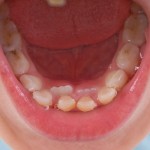
The aim of this study was to compare the outcome of partial pulpotomies in cariously exposed pulps of young permanent molars using mineral trioxide aggregate (MTA) and calcium hydroxide in a randomized controlled trial. Eighty-four teeth in 80 patients (aged 7-10yrs) having one or two first permanent molars with deep occlusal carious lesions that resulted [read the full story…]

